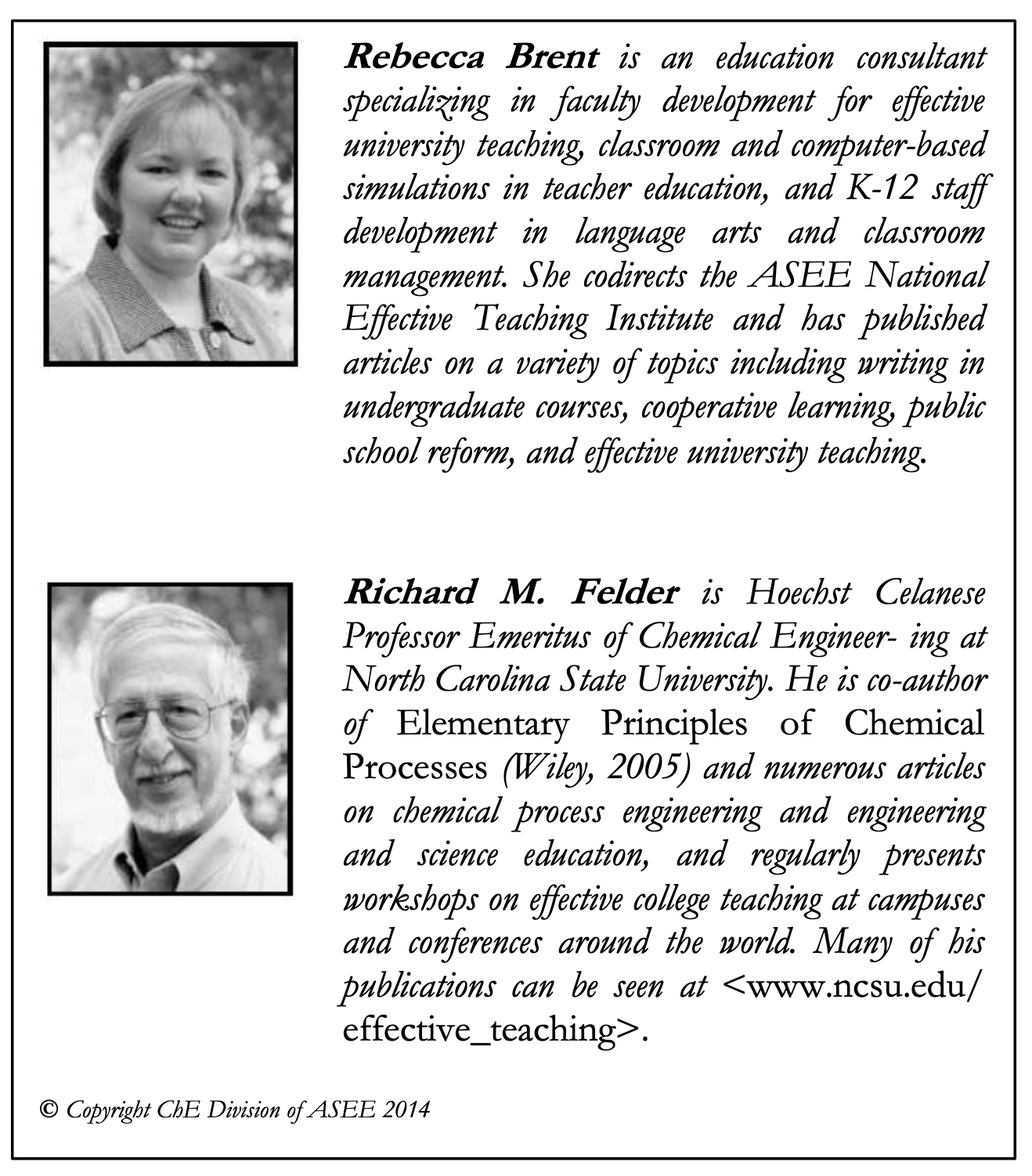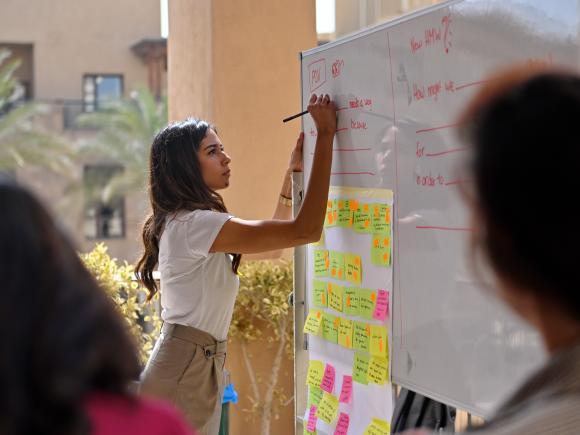A word from the CLT Director:
Welcome to a new academic year and I hope you are having a productive start. This is our first
Aziza Ellozy
“New Chalk Talk” issue this semester and we are reprinting with permission an article by R.
Felder and R. Brent who are world-renowned for their workshops on effective teaching. Richard
Felder has been a world leader in chemical engineering education and engineering education research for decades1
Ever hear a conversation like this in your department?

Professor X: “All these students can do is plug
numbers into formulas—give them a problem a little
different from the one in the text and they’re helpless.”
Professor Y: “Yeah, and they’re also functionally
illiterate—most of them couldn’t write a coherent
grocery list. On a quiz last month I asked for a clear
and grammatically correct definition of vapor pressure, and a bunch of the students stomped me for it on the midterm evals. ‘I went into engineering to get away from this crap,’ one of them said.”
Professor Z: “It’s this whole spoiled generation—
they want the grades but don’t want to do anything for them!”
If you haven’t heard anything like that, you
haven’t been listening. Two popular targets on the list of Things
These Students Can’t Do are creative thinking (coming up with innovative ideas) and critical thinking (making judgments or choices and backing them up with evidence and logic). When our colleagues complain to us that their students can’t do them, after we make appropriate sympathetic noises we ask, “Where were they supposed to learn to do it?” The answers may vary, but one we rarely hear is “In my class.”
Leaving aside anomalous prodigies like Mozart and Gauss, people develop skills of any kind— musical performance or composition, math or physics, critical or creative thinking—through a lot of practice and feedback. That’s how you acquired your skills. You were either given or voluntarily took on tasks, and with someone else’s help or on your own you learned how to do them. The more you did them, the better you got. Unfortunately, creative and critical thinking are not routinely taught in our schools, nor are they activities that students eagerly learn on their own. It shouldn’t surprise us when our students can’t magically do them on our assignments and exams.
Let’s suppose you decide to take on the job of helping your students learn to think creatively or critically. Can you equip all of them to be brilliant at it? No, any more than you or anyone else can turn them all into brilliant scientists and engineers—they don’t all have the talent. How about the ones who have it—can you do it for all of them? Probably not—some lack the motivation to do the required work. Well then, can you help the talented and motivated students become much better at creative and critical thinking than they were at the beginning of the course? Definitely! How? Easy—show them examples of the kind of thinking you have in mind; ask them in class and in assignments to complete tasks that require that kind of thinking; give them feedback; and repeat.
In the remainder of this column we offer examples of creative and critical thinking tasks you can
easily incorporate into your course—any course, on any subject—that should require relatively little
time to prepare and grade and not much expertise (if you’re worried about your own creative and
thinking skills). To design more extensive instructional modules or courses on creative and critical
thinking, consult references on those subjects. A particularly good source of information is Fogler
and LeBlanc’s
Strategies for Creative Problem Solving,[1] which also deals with critical thinking. Also, consider using a
grading rubric to evaluate the students’ products and help them develop the targeted skill. [2]
1 http://www4.ncsu.edu/unity/lockers/users/f/felder/public/RMF.html
Creative and critical thinking: Idea generation and prioritization.
(Creative) List possible
- ways to verify a [calculated value, derived formula]
- ways to determine a physical property or process variable [as a function of one or more specified variables, with no instrument calibrations, using a stuffed bear]
- uses for [a specified object, a waste product]
- ways to improve a [process, product, experiment, procedure, computer code]
- real-world applications of a [theory, formula, algorithm]
- safety or environmental concerns in [an experiment, a process, a plant]
- flaws in a proposed [design, procedure]
- benefits of doing something differently from how it is normally done
You could stop right there, or you could go on to (Critical) Select the top three items on your list in
decreasing order of their probable importance, and justify your selection.
Creative and critical thinking: Explaining unexpected results (perhaps the most important task scientists and engineers face, both in industry and in research). (b) In Part (a) of this problem, you
calculated that the cantilever support should fail when the applied load reaches 5.5×104 N. Suppose a test is run and the support fails at a load of only 2.1×104 N. (Creative) List at least 10 possible reasons, including three or more that involve assumptions made in the calculation. (Critical) List the top three reasons on your list in decreasing order of their likelihood, and justify your selection.
Creative and critical thinking: Problem formulation.
“[Make up, make up and solve] a problem involving material covered in the past two weeks of [this course, this course and any other course you are currently taking]. If your problem requires only simple formula substitution and contains no errors, you will get a minimum passing grade. To get more credit, your problem should require high-level analysis or critical or creative thinking to solve.” Formulating the problem requires creative thinking, and determining whether or not it meets your criteria calls for critical thinking. Before you give the first such assignment, show in class several examples of poorly constructed and low-level problems and examples of well-constructed problems that meet your criteria.
Critical thinking: Selecting from among alternatives. Following are [two strategies for solving a given
problem, two computer codes for executing a stated task, four alternative process or product designs, four possible explanations of given observations or experimental data]. Select the best one and justify your choice.
Critical thinking: Analyzing. Assign a complex open-ended problem, with the first task being to
determine whether enough information is available to get a solution, and if it isn’t, to figure out
what more is needed and how to find it. Another analysis problem involves an ethical dilemma. The
following scenario describes the case of [an employee who learns about an illegal activity that involved his supervisor; a graduate student who discovers that her research advisor altered experimental data]. List and discuss possible courses of action and make and justify a recommendation.
Critical thinking: Critiquing. Read and critique the attached [article from a popular scientific journal, op-ed column in yesterday’s paper, transcript of a televised speech or interview]. Your critique should include an evaluation of the accuracy and persuasiveness of the opinions expressed and should identify stated and hidden assumptions, misleading statements, and inaccurate and unproven claims.
Critical thinking: Grading. A student who took this course last year submitted the attached [project report, design, essay]. Give it a grade and summarize your reasoning.
Whichever of those exercises you use, there’s a good chance many students have never been asked
to do anything like it before. Don’t ask them to do it without first giving them a clear idea of what you are looking for. A good way to do that is to first show several good and bad examples of student products in class, state how you would grade each one, and explain what makes them good or bad. Then give several more examples, and for each one, (a) have the students rate it individually; (b) have them compare their ratings in pairs and reach consensus on the appropriate rating; and (c) share your rating with them and discuss your reasoning. After several such exercises they will all know what you want them to do, and most should do reasonably well on their first attempts and much better thereafter. By the end of your course they may not all be brilliant creative or critical thinkers, but they will have taken a major step in that direction.
1 Fogler,H.S.,andLeBlanc,S.E.,withRizzo,B.R.(2014).Strategies for Creative Problem Solving, 3rd edn. Upper Saddle River, NJ: Pearson Education.
2 Felder, R.M., and Brent, R. (2010). Hard assessment of soft skills. Chem. Engr. Education, 44(1), 63–64. www.ncsu.edu/felder-public/ Columns/SoftSkills.pdf. A good starting point for developing a grading rubric or checklist is http://course1.winona.edu/shatfield/air/rubrics.html

